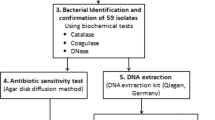Abstract
Purpose
Staphylococcus lugdunensis has emerged as a major human pathogen, capable of causing significant infections at many sites. It should never be dismissed as a contaminant without careful review. We report 16 cases of wound infections and skin and soft tissue abscesses caused by S. lugdunensis during a period of 3.5 years (January 2008–June 2011). These cases were isolated from clinical specimens in a tertiary hospital (250 beds) in Athens, Greece.
Methods
The identification of S. lugdunensis was based on Gram staining, catalase and coagulase test results, and 26 biochemical reactions that were included in the database of the MicroScan Walkaway 96 commercial system. The susceptibility pattern was performed with the same commercial system according to CLSI recommendations.
Results
Twenty-five isolates were classified as S. lugdunensis, of which 16 were considered to be clinically significant. The age distribution of the patients ranged from 29 to 65 years. Patient outcome after treatment was good with no long-term sequel. All isolated S. lugdunensis were methicillin sensitive (cefoxitin screen negative), while five isolates were β-lactamase producers. The isolates were susceptible to most of the antibiotics tested except for a few cases that were resistant to erythromycin, tetracycline, and clindamycin.
Conclusions
Coagulase-negative staphylococci isolated from traumatic and surgical wound infections should be identified by microbiological laboratories to the species level, and susceptibility testing should be performed on these isolates so as not to underrate the virulence of staphylococci resembling S. aureus.
Similar content being viewed by others
References
J Freney J, Brun Y, Bes M, et al. Staphylococcus lugdunensis sp. nov. and Staphylococcus schleiferi sp. nov. Two species from human clinical specimens. IJSEM. 1988;38:168–172.
Vandenesch F, Eykyn SJ, Etienne J, Lemozy J. Skin and post-surgical wound infections due to Staphylococcus lugdunensis. Clin Microbiol Infect. 1995;1:73–4.
Kragsbjerg P, Bomfim-Loogna J, Törnqvist E, Söderquist B. Development of antimicrobial resistance in Staphylococcus lugdunensis during treatment-report of a case of bacterial arthritis, vertebral osteomyelitis and infective endocarditis. Clin Microbiol Infect. 2000;6:496–9.
Tee WS, Soh SY, Lin R, Loo LH. Staphylococcus lugdunensis carrying the mecA gene causes catheter -associated bloodstream infection in premature neonate. J Clin Microbiol. 2003;41:519–20.
Sampathkumar P, Osmon DR, Cockerill FR 3rd. Prosthetic joint infection due to Staphylococcus lugdunensis. Mayo Clin Proc. 2000;75:511–2.
Hellbacher C, Törnqvist E, Söderquist B. Staphylococcus lugdunensis: clinical spectrum, antibiotic susceptibility, and phenotypic and genotypic patterns of 39 isolates. Clin Microbiol Infect. 2006;12:43–9.
Arias M, Tena D, Apellániz M, et al. Skin and soft tissue infections caused by Staphylococcus lugdunensis: report of 20 cases. Scand J Infect Dis. 2010;42:879–84.
Böcher S, Tønning B, Skov RL, Prag J. Staphylococcus lugdunensis, a common cause of skin and soft tissue infections in the community. J Clin Microbiol. 2009;47:946–50.
Clinical and Laboratory Standards Institute: Performance standards for antimicrobial susceptibility testing. Eighteenth informational supplement Vol. 28, No1. Wayne, PA: Clinical and Laboratory Institute Standard Institute; 2008.
Eron LJ, Lipsky BA, Low DE, Nathwani D, Tice AD, Volturo GA. Expert panel on managing skin and soft tissue infections. Managing skin and soft tissue infections: expert panel recommendations on key decision points. J Antimicrob Chemother. 2003;52:i3–17.
Herchline TE, Ayers LW. Occurrence of Staphylococcus lugdunensis in consecutive clinical cultures and relationship of isolation to infection. J Clin Microbiol. 1991;29:419–21.
Ortiz de la Tabla V, Gutiérrez-Rodero F, Martín C, Zorraquino A, Belinchón I. Staphylococcus lugdunensis as a cause of abscesses in the perineal area. Eur J Clin Microbiol Infect Dis. 1996;15:405–407.
Bellamy R, Barkham T. Staphylococcus lugdunensis infection sites: predominance of abscesses in the pelvic girdle region. Clin Infect Dis. 2002;35:E32–4.
Gatermann SG, Koschinski T, Friedrich S. Distribution and expression of macrolide resistance genes in coagulase-negative staphylococci. Clin Microbiol Infect. 2007;13:777–81.
Mateo M, Maestre JR, Aguilar L, et al. Genotypic versus phenotypic characterization, with respect to susceptibility and identification, of 17 clinical isolates of Staphylococcus lugdunensis. J Antimicrob Chemother. 2005;56:287–91.
Ebright JR, Penugonda N, Brown W. Clinical experience with Staphylococcus lugdunensis bacteremia: a retrospective analysis. Diagn Microbiol Infect Dis. 2004;48:17–21.
Tan TY, Ng SY, He J. Microbiological characteristics, presumptive identification, and antibiotic susceptibilities of Staphylococcus lugdunensis. J Clin Microbiol. 2008;46:2393–5.
Frank KL, Del Pozo JL, Patel R. From clinical microbiology to infection pathogenesis: how daring to be different works for Staphylococcus lugdunensis. Clin Microbiol Rev. 2008;21:111–33.
Fleurette J, Bès M, Brun Y, et al. Clinical isolates of Staphylococcus lugdunensis and S. schleiferi: bacteriological characteristics and susceptibility to antimicrobial agents. Res Microbiol. 1989;140:107–18.
Vandenesch F, Etienne J, Reverdy ME, Eykyn SJ. Endocarditis due to Staphylococcus lugdunensis: report of 11 cases and review. Clin Infect Dis. 1993;17:871–6.
You YO, Kim KJ, Min BM, Chung CP. Staphylococcus lugdunensis-a potential pathogen in oral infection. Oral Surg Oral Med Oral Pathol Oral Radiol Endod. 1999;88:297–302.
Ferreira RB, Iorio NL, Malvar KL, et al. Coagulase-negative staphylococci: comparison of phenotypic and genotypic oxacillin susceptibility tests and evaluation of the agar screening test by using different concentrations of oxacillin. J Clin Microbiol. 2003;41(8): 3609–14. Erratum: J Clin Microbiol. 2004;42:3913.
Shin JH, Jung HJ, Lee HR, Kim JH, Kim HR, Lee JN. Prevalence, identification, and antimicrobial susceptibility of Staphylococcus lugdunensis from various clinical specimens in Korea. Jpn J Infect Dis. 2007;60:312–3.
Hussain Z, Stoakes L, Massey V, et al. Correlation of oxacillin MIC with mecA gene carriage in coagulase-negative staphylococci. J Clin Microbiol. 2000;38:752–4.
Acknowledgments
Special thanks to Tsiaganika Spiridoula for her technical assistance.
Conflict of interest
None.
Author information
Authors and Affiliations
Corresponding author
Rights and permissions
About this article
Cite this article
Papapetropoulos, N., Papapetropoulou, M. & Vantarakis, A. Abscesses and wound infections due to Staphylococcus lugdunensis: report of 16 cases. Infection 41, 525–528 (2013). https://doi.org/10.1007/s15010-012-0381-z
Received:
Accepted:
Published:
Issue Date:
DOI: https://doi.org/10.1007/s15010-012-0381-z




